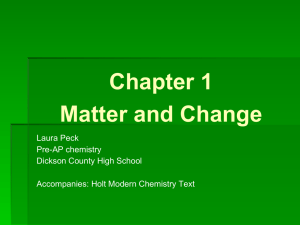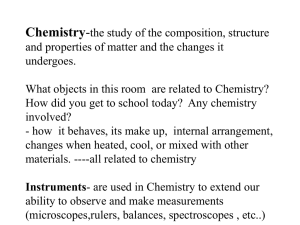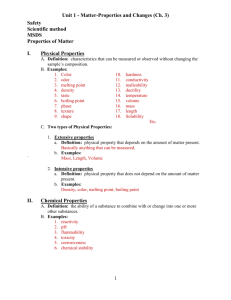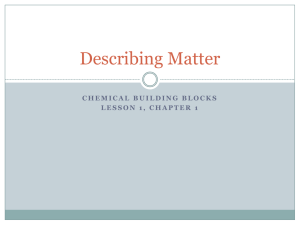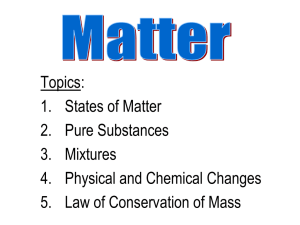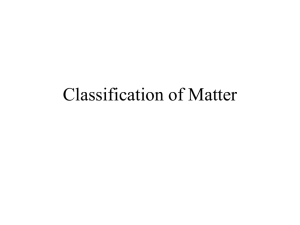Matter
advertisement
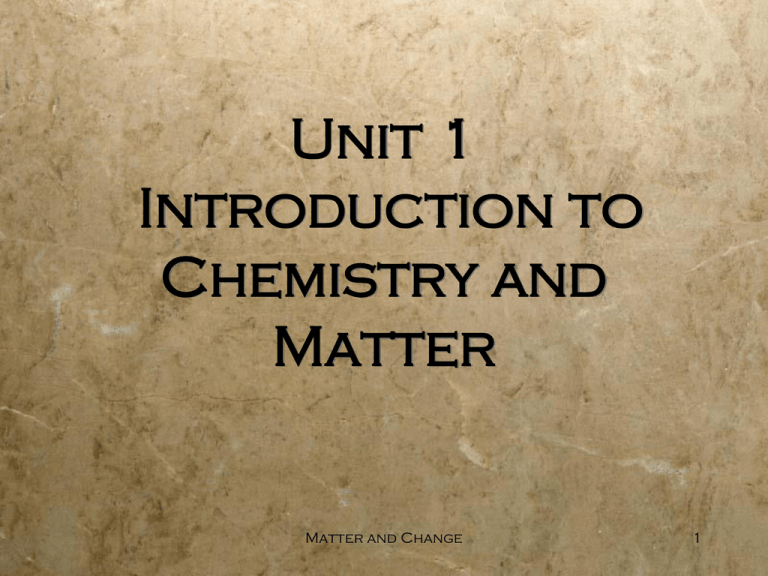
Unit 1 Introduction to Chemistry and Matter Matter and Change 1 Chapter 1 Matter and Change Physical Science review Matter and Change 2 Section 1.1 Objectives Define Chemistry List examples of the branches of chemistry Compare and contrast basic research, applied research, and technological development. Matter and Change 3 What is Chemistry? Chemistry is the study of the composition, structure, and properties of matter and the changes it undergoes It deals with questions such as, What is material made of? What is its make up? How does it behave when heated or cooled? Matter and Change 4 Branches of Chemistry Organic Chemistry - the study of carbon containing compounds. Inorganic Chemistry - study of all substances that do not contain carbon. Physical Chemistry - study of the properties, changes, and relationships between energy and matter. Matter and Change 5 Branches Continued Analytical Chemistry - identification of the components and composition of materials. Biochemistry - study of substances and processes occurring in living things. Theoretical Chemistry - the use of mathematics and computers to design, predict, and understand the properties of new compounds. Matter and Change 6 In all areas of chemistry, scientists work with chemicals. A chemical is any substance that has a definite composition. Example: Sucrose is a sugar. It has definite composition in terms of atoms that compose it (C, H, and O Atoms). Matter and Change 7 Basic research Basic Research Goal: To increase knowledge, such as, how and why a specific reaction occurs or what the properties of a substance are? Matter and Change 8 Applied Research When using applied science, scientists are not driven by pure curiosity, but by a need to solve a problem created by specific needs. Matter and Change 9 Technological development Technology employs existing knowledge gained from basic and applied research to make life easier or more convenient. Matter and Change 10 Section 1.2 Objectives Physical Properties vs. Chemical Properties Classify changes in matter as physical or chemical. Explain the gas, liquid, and solid states in terms of particles. Explain how the law of conservation oe energy applies to changes in matter. Mixture vs. a Pure Substance. Matter and Change 11 1.2 Matter and Its Properties Mass is the measure of the amount of Matter Volume is the amount of space something takes up Matter is anything that has mass and takes up space The fundamental building block of matter are atoms These particles make up elements and compounds. Matter and Change 12 Atoms, Elements, and Compounds An atom is the smallest unit of an element that maintains the properties of that element. An element is a pure substance made of one kind of atom. A compound is a substance that is made from the atoms of two or more elements that are chemically bonded. Matter and Change 13 Properties and Changes in Matter Chemists use properties (characteristics) to distinguish between substances and to separate them. Extensive properties depend on the amount of matter present Example - mass, volume, energy in a substance Matter and Change 14 Properties cont Intensive properties do not depend on the amount of matter Present. Example - melting point, boiling point and density Matter and Change 15 Physical Properties and Physical Changes A physical property is a characteristic that can be observed or measured without changing the identity of the substance. Examples : melting and boiling point Physical change - a change in a substance that does not involve a change in the identity of a substance. Matter and Change 16 Chemical Properties and chemical Changes A chemical property relates to a substances ability to undergo changes that transform into different substances. A change in which one or more substances are converted into different substances is called a chemical change or chemical reaction. Matter and Change 17 Matter and Change 18 Chemical Changes Substances that react are called reactants. Substances that are formed are called products. 1CH4 (g) + 2O2 (g) 1CO2 (g) + 2H2O Reactants Products Arrows and + signs can be substituted for the words yields and plus. Matter and Change 19 Remember: Chemical properties involve the change in the chemical make up of a substance. Matter and Change 20 In other words the substance was involved in a chemical Solids, Liquids, and Gases Change of State - a physical change of a substance form one state to the other Matter in the solid state has definite volume and definite shape. Particles are closely packed. Matter in the liquid state has definite volume but not definite shape. Particles are loosely packed Matter in the gas state has neither definite volume or shape. Particles are free to roam container. Matter and Change 21 Tightly packed Loosely packed Free to roam (fixed positions) (can slide past one another) Matter and Change 22 Classification of Matter All matter can be classified into one of two groups: Pure Substances or Mixtures. Pure Substances, which can be elements or compounds. Compounds are atoms of more than one element coming together to form a new substance. The composition of a pure substance is the same through out and does not vary form sample to sample. Example : The element Carbon or the compound COMatter - carbon monoxide and Change 23 Pure Substances vs.. Mixtures cont In contrast, Mixtures contain more than one substance. They can vary in composition and properties from one part of a sample to another part of the same sample Mixtures are therefore a blend between two or more pure substances (compounds or elements) each of which retains its own properties. Example: KoolAid - Sugar + water Matter and Change 24 Mixtures Mixtures can be one of two types: Homogenous Heterogeneous Homogeneous are uniform in composition. They are referred to as solutions. Heterogeneous mixtures are not the same throughout. Matter and Change 25 Matter and Change 26 Section 1.3 Objectives Describe the arrangement of the periodic table. List the characteristics that distinguish metals, nonmetals, and metalloids. Matter and Change 27 Section 1-3 Elements And review of the Periodic Table Elements are pure substances that cannot be broken down by chemical changes. The elements are organized into groups called the periodic table. Matter and Change 28 The Periodic Table The vertical columns of the periodic table are called groups. The horizontal rows of elements are called periods. The two sets of elements placed below the table make up the lanthanide and actinide series. These metallic elements fit into the table just after elements 57 and 89. They are placed below so the table isn’t too wide and can be fit on one sheet of paper. Matter and Change 29 Types of Elements The P.T. is divided into two main sections: Metals and Nonmetals Metals are located to the left and in the middle. Nonmetals are located on the right The stair step line shows characteristics of both metals and nonmetals. These are called metalliods Matter and Change 30 Metals A metal is an element that is a good conductor of heat and electricity. Not extraordinarily hard Properties: Malleability (can be hammered into thin sheets), ductile (can be drawn into fine wire), and have high tensile strength (the ability to resist breaking) Luster – the shininess of a metal Matter and Change 31 NonMetals A nonmetal is an element that is a poor conductor of heat and electricity. Usually found in gaseous form @ room temperature. Bromine is a liquid @ room temp. If in solid form are Brittle Example - Sulfur Matter and Change 32 Metalliods A metalliod is an element that has some characteristics of metals and some characteristics of nonmetals Matter and Change 33
